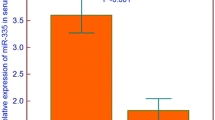Abstract
A genome-wide serum miRNA expression analysis previously showed the upregulation of microRNA-375 (miR-375) in acute myeloid leukemia (AML) patients compared with healthy controls. The aim of this study was to investigate the expression patterns and the prognostic relevance of miR-375 in pediatric AML. Expression levels of miR-375 in bone marrow mononuclear cells were detected by real-time quantitative PCR in a cohort of 106 patients with newly diagnosed pediatric AML. Expression levels of miR-375 in the bone marrow of pediatric AML patients were significantly higher than those in normal controls (P < 0.001). Then, miR-375 upregulation occurred more frequently in French–American–British classification subtype M7 than in other subtypes (P < 0.001). Regarding to cytogenetic risk, the expression levels of miR-375 in pediatric AML patients with unfavorable karyotypes were dramatically higher than those in intermediate and favorable groups (P = 0.002). Moreover, high miR-375 expression was significantly associated with shorter relapse-free survival (P < 0.001) and overall survival (P < 0.001) in pediatric AML patients. Multivariate analysis further identified miR-375 expression and cytogenetics risk as independent prognostic factors for both relapse-free survival and overall survival. In particular, the prognostic relevance of miR-375 expression was more obvious in the subgroup of patients with intermediate-risk cytogenetics. Our findings suggest for the first time that the upregulation of miR-375 may be one of the molecular mechanisms involved in the development and progression of pediatric AML. Since its correlation with poor relapse-free survival and overall survival, miR-375 may be a novel biomarker to improve the management of pediatric AML patients.



Similar content being viewed by others
References
Estey EH (2013) Acute myeloid leukemia: 2013 update on risk-stratification and management. Am J Hematol 88:318–327
Ganetsky A (2012) The role of decitabine for the treatment of acute myeloid leukemia. Ann Pharmacother 46:1511–1517
Puumala SE, Ross JA, Aplenc R, Spector LG (2013) Epidemiology of childhood acute myeloid leukemia. Pediatr Blood Cancer 60:728–733
Danen-van Oorschot AA, Kuipers JE, Arentsen-Peters S et al (2012) Differentially expressed miRNAs in cytogenetic and molecular subtypes of pediatric acute myeloid leukemia. Pediatr Blood Cancer 58:715–721
Liu X, Liu L, Xu Q, Wu P, Zuo X, Ji A (2012) MicroRNA as a novel drug target for cancer therapy. Expert Opin Biol Ther 12:573–580
Esteller M (2011) Non coding RNAs in human disease. Nat Rev Genet 12(861):874
van Kouwenhove M, Kedde M, Agami R (2011) MicroRNA regulation by RNA binding proteins and its implications for cancer. Nat Rev Cancer 11:644–656
Dela Cruz F, Matushansky I (2011) MicroRNAs in chromosomal translocation associated solid tumors: learning from sarcomas. Discov Med 12:307–317
Jansson MD, Lund AH (2012) MicroRNA and cancer. Mol Oncol 6:590–610
Nana-Sinkam SP, Croce CM (2013) Clinical applications for microRNAs in cancer. Clin Pharmacol Ther 93:98–104
Marcucci G, Maharry KS, Metzeler KH et al (2013) Clinical role of microRNAs in cytogenetically normal acute myeloid leukemia: miR-155 upregulation independently identifies high-risk patients. J Clin Oncol 31:2086–2093
Cimmino A, Calin GA, Fabbri M et al (2005) miR-15 and miR-16 induce apoptosis by targeting BCL2. Proc Natl Acad Sci USA 102:13944–13949
Lopotová T, Záčková M, Klamová H, Moravcová J (2011) MicroRNA-451 in chronic myeloid leukemia: miR-451–BCR–ABL regulatory loop? Leuk Res 35:974–977
Bai J, Guo A, Hong Z, Kuai W (2012) Upregulation of microRNA-100 predicts poor prognosis in patients with pediatric acute myeloid leukemia. Onco Targets Ther 5:213–219
Zhu C, Wang Y, Kuai W, Sun X, Chen H, Hong Z (2013) Prognostic value of miR-29a expression in pediatric acute myeloid leukemia. Clin Biochem 46:49–53
Zhi F, Cao X, Xie X et al (2013) Identification of circulating microRNAs as potential biomarkers for detecting acute myeloid leukemia. PLoS ONE 8:e56718
Croce CM (2013) MicroRNA dysregulation in acute myeloid leukemia. J Clin Oncol 31:2065–2066
Poy MN, Eliasson L, Krutzfeldt J et al (2004) A pancreatic islet-specific microRNA regulates insulin secretion. Nature 432:226–230
Siow M, Karen-Ng L, Vincent-Chong V et al (2013) Dysregulation of miR-31 and miR-375 expression is associated with clinical outcomes in oral carcinoma. Oral Dis (in press)
Chang C, Shi H, Wang C et al (2012) Correlation of microRNA-375 downregulation with unfavorable clinical outcome of patients with glioma. Neurosci Lett 531:204–208
Xu Y, Deng Y, Yan X, Zhou T (2011) Targeting miR-375 in gastric cancer. Expert Opin Ther Targets 15:961–972
Komatsu S, Ichikawa D, Takeshita H et al (2012) Prognostic impact of circulating miR-21 and miR-375 in plasma of patients with esophageal squamous cell carcinoma. Expert Opin Biol Ther 12(Suppl 1):S53–S59
Wang F, Li Y, Zhou J et al (2011) miR-375 is down-regulated in squamous cervical cancer and inhibits cell migration and invasion via targeting transcription factor SP1. Am J Pathol 179:2580–2588
Yabushita S, Fukamachi K, Tanaka H et al (2012) Circulating microRNAs in serum of human K-ras oncogene transgenic rats with pancreatic ductal adenocarcinomas. Pancreas 41:1013–1018
Li Y, Jiang Q, Xia N, Yang H, Hu C (2012) Decreased expression of microRNA-375 in nonsmall cell lung cancer and its clinical significance. J Int Med Res 40:1662–1669
Chang Y, Yan W, He X et al (2012) miR-375 inhibits autophagy and reduces viability of hepatocellular carcinoma cells under hypoxic conditions. Gastroenterology 143(177–87):e8
Zhao H, Zhu L, Jin Y, Ji H, Yan X, Zhu X (2012) miR-375 is highly expressed and possibly transactivated by achaete–scute complex homolog 1 in small-cell lung cancer cells. Acta Biochim Biophys Sin (Shanghai) 44:177–182
Dai X, Chiang Y, Wang Z et al (2012) Expression levels of microRNA-375 in colorectal carcinoma. Mol Med Rep 5:1299–1304
Conflict of interest
None.
Author information
Authors and Affiliations
Corresponding author
Rights and permissions
About this article
Cite this article
Wang, Z., Hong, Z., Gao, F. et al. Upregulation of microRNA-375 is associated with poor prognosis in pediatric acute myeloid leukemia. Mol Cell Biochem 383, 59–65 (2013). https://doi.org/10.1007/s11010-013-1754-z
Received:
Accepted:
Published:
Issue Date:
DOI: https://doi.org/10.1007/s11010-013-1754-z




